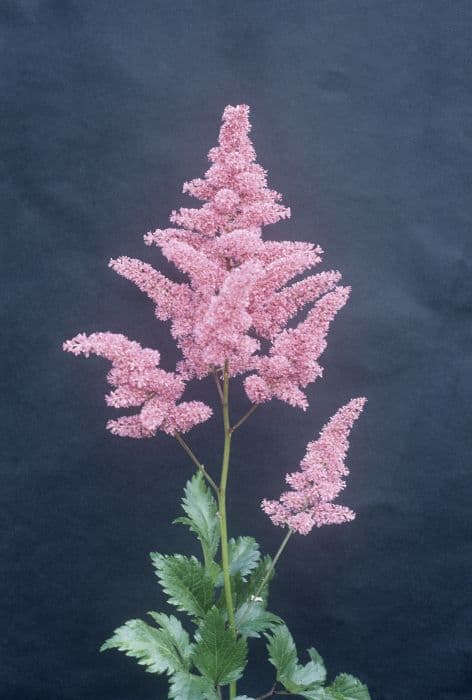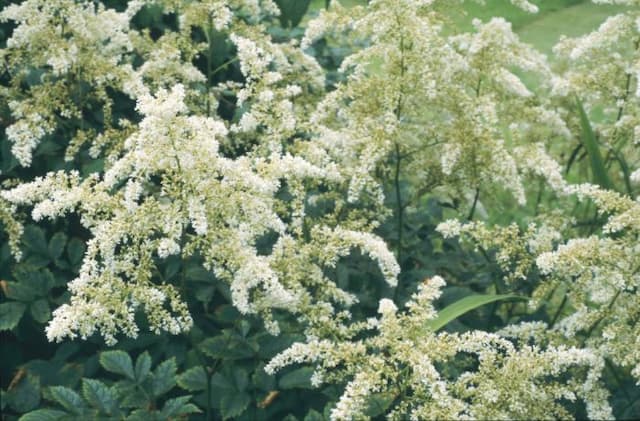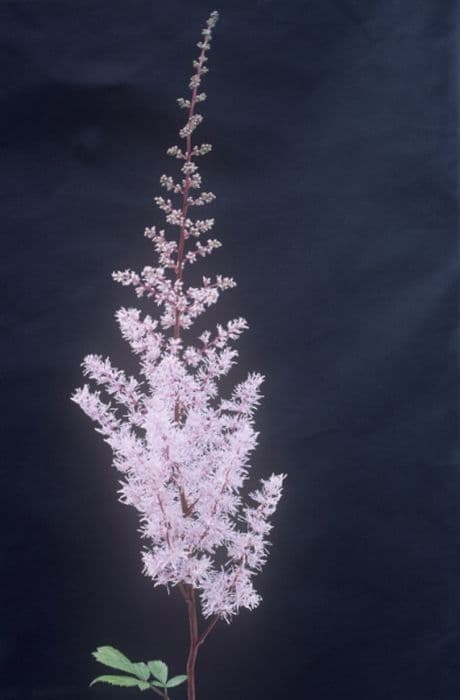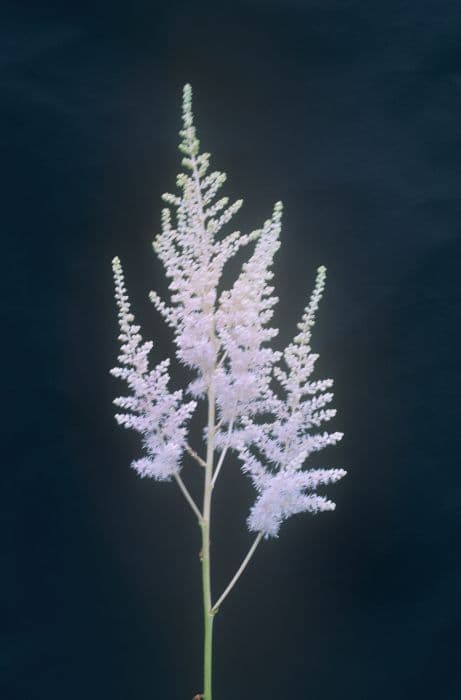Heucherella 'Brass Lantern' × Heucherella 'Brass Lantern' (PBR)

ABOUT
'Brass Lantern' is a perennial to 60cm in height. The lobed leaves are tinted gold-bronze with dark red veining from spring to autumn, turning olive-green to brown in winter. Panicles of small, bell-shaped white flowers are held above the foliage on deep-red stems from spring to summer
About this plant
 Names
NamesFamily
Saxifragaceae
Synonyms
Foamy Bells, Heucherella
Common names
× Heucherella 'Brass Lantern' (PBR)
 Characteristics
CharacteristicsLife cycle
Perennials
Foliage type
Semi-deciduous
Color of leaves
Mixed
Flower color
White
Height
1 foot 8 inches (0.5 meters)
Spread
1 foot 8 inches (0.5 meters)
Plant type
Herb
Hardiness zones
4
Native area
North America
Benefits
 General Benefits
General Benefits- Attractive Foliage: The plant features striking, multicolored leaves that add visual interest to garden landscapes.
- Low Maintenance: It requires minimal care beyond basic watering and occasional fertilization, making it suitable for busy gardeners.
- Drought Tolerant: Once established, it can withstand periods without water, ideal for regions with water restrictions or low rainfall.
- Pest Resistant: It is generally resistant to common garden pests, reducing the need for chemical treatments.
- Shade Tolerant: It can grow in the shaded parts of a garden, offering flexibility in garden design and plant placement.
- Seasonal Interest: The plant has a long growing season with ever-changing leaf colors that provide year-round interest in the garden.
- Compact Size: Its moderate growth habit makes it suitable for small gardens, containers, and borders without worrying about it overpowering nearby plants.
- Easy to Propagate: It can be easily multiplied by division, allowing gardeners to spread its beauty around different parts of the garden.
- Attracts Wildlife: While not flowering extensively, it can still attract beneficial insects to the garden, such as pollinators.
- Versatile Use: Suitable for use in mixed beds, as ground cover, or in rock gardens, making it a versatile plant for various landscaping projects.
 Medical Properties
Medical PropertiesThis plant is not used for medical purposes.
 Air-purifying Qualities
Air-purifying QualitiesThis plant is not specifically known for air purifying qualities.
 Other Uses
Other Uses- Illustrative Art: The vibrant foliage of Heucherella 'Brass Lantern' can be used as a subject for botanical illustrations and garden drawings, providing artists with intricate patterns and colors to replicate.
- Photography Background: The plant's striking leaves provide a unique backdrop for macro photography, enhancing the visual appeal of close-up photographs of insects or other small garden features.
- Educational Tool: Utilized in botany and horticulture courses to teach about hybrid plant development and the cultivation of ornamental plants.
- Culinary Garnish: Though not commonly eaten, the colorful leaves could adorn dishes for special occasions where an edible garnish is not required but aesthetics are valued.
- Theme Gardens: Used in fairy or fantasy-themed gardens to create an enchanting atmosphere with its lush, colorful foliage.
- Seasonal Decoration: The leaves can be incorporated into fall floral arrangements or wreaths to add autumnal hues to home decor.
- Craft Projects: Pressed leaves of Heucherella 'Brass Lantern' can be used in scrapbooking, card making, or other paper crafts for texture and color.
- Container Combinations: Planted in mixed containers, it can play a supporting role complementing flowering plants with its foliage.
- Plant Swap: Gardeners could use this plant as a trading piece in plant swap events, being an attractive and less common hybrid to exchange with other enthusiasts.
- Fashion Inspiration: The striking leaf patterns can inspire textile designs for clothing, accessories, or home fabrics.
Interesting Facts
 Feng Shui
Feng ShuiThe plant Foamy Bells is not used in Feng Shui practice.
 Zodiac Sign Compitability
Zodiac Sign CompitabilityThe plant Foamy Bells is not used in astrology practice.
 Plant Symbolism
Plant Symbolism- Resilience: Heucherella 'Brass Lantern', being a hardy and adaptable plant, often symbolizes the ability to weather challenges and thrive in various conditions.
- Transformation: With its changing leaf color throughout the seasons, the Heucherella represents transformation and adaptability in life.
- Innovation: As a hybrid plant, the Heucherella 'Brass Lantern' symbolizes innovation and creative endeavors that combine different elements to form something new and beautiful.
- Harmony: The plant’s requirement for balance in sunlight and shade reflects the symbolic meaning of harmony and the quest for balance in our lives.
 Water
WaterFoamy Bells, commonly known as Heucherella 'Brass Lantern', prefer consistent moisture, so water them when the top inch of soil feels dry to the touch. In general, this might mean watering once or twice a week, depending on the local climate and weather conditions; however, be careful not to overwater as they do not like soggy soil. A good approach is to water deeply, providing about one gallon of water per plant, ensuring it reaches the roots. During the hotter months, you might need to water more frequently to maintain consistent soil moisture, while in cooler months, watering can be reduced.
 Light
LightFoamy Bells thrive in part shade to full shade conditions. They prefer a spot that receives filtered sunlight or morning sun followed by afternoon shade to protect their foliage. Avoid exposing them to the harsh afternoon sun, which can scorch their delicate leaves. An ideal location would be under the canopy of a tree or on the north side of a building where they can be protected from intense direct light.
 Temperature
TemperatureFoamy Bells are hardy and can withstand temperatures as low as 20 degrees Fahrenheit, making them suitable for many gardens. They perform best in a range of 60 to 70 degrees Fahrenheit, which encourages healthy growth and flowering. It's important to protect them from extreme cold and frost, which could damage the plant. Conversely, they can tolerate high temperatures as long as they are not coupled with direct sunlight, which can be harmful.
 Pruning
PruningPruning Foamy Bells is mainly done to remove any dead or damaged foliage and to maintain a tidy appearance. Light pruning can be done as needed throughout the growing season, but a more thorough cleanup is beneficial in early spring to make way for new growth. The best time for major pruning is after the last frost when the risk of cold damage has passed.
 Cleaning
CleaningAs needed
 Soil
SoilFoamy Bells prefer well-draining soil with a mix of peat, perlite, and compost. Aim for a slightly acidic to neutral pH, between 5.5 and 7.0.
 Repotting
RepottingFoamy Bells should be repotted every two to three years to refresh the soil and encourage healthy growth.
 Humidity & Misting
Humidity & MistingFoamy Bells thrive best at moderate humidity levels, around 50% to 60%.
 Suitable locations
Suitable locationsIndoor
Place Foamy Bells in filtered light; water when topsoil is dry.
Outdoor
Part shade location, protect from intense afternoon sun.
Hardiness zone
4-9 USDA
 Life cycle
Life cycle× Heucherella 'Brass Lantern', commonly known as Foamy Bells, begins its life from a seed or more commonly from division. Once germinated or planted, the plant enters the growth stage where it develops a clump-forming habit, producing maple-shaped, predominantly bronze-red leaves with a decorative mosaic of golden-green. Throughout spring and intermittently into fall, Foamy Bells produce delicate, small white to pink flowers on wiry stems that rise above the foliage. After blooming, the flowers eventually wither, and if seeds are produced, they can be dispersed to form new plants, though many cultivars are propagated vegetatively. During the winter, the plant may die back, especially in colder climates, entering a period of dormancy. With the return of warmer temperatures in spring, new growth emerges from the crown, repeating the life cycle.
 Propogation
PropogationPropogation time
Spring-early summer
Propogation: The × Heucherella 'Brass Lantern' (PBR), more commonly known as Foamy Bells, is typically propagated through division. The best time to propagate the Foamy Bells through division is in the spring or early fall when the plant is not in active bloom. To divide the plant, carefully dig up the entire clump and gently separate the crown and root system into smaller sections, each with a fair amount of roots and at least one or two growth points or shoots. These divisions can then be replanted in well-prepared soil, spaced about 15 to 18 inches (approximately 38 to 46 cm) apart to allow ample room for growth. It is important to water the new divisions thoroughly after planting to help establish them. Ensure that the divisions are not planted deeper than they were originally growing, as this could adversely affect the plant's performance.









